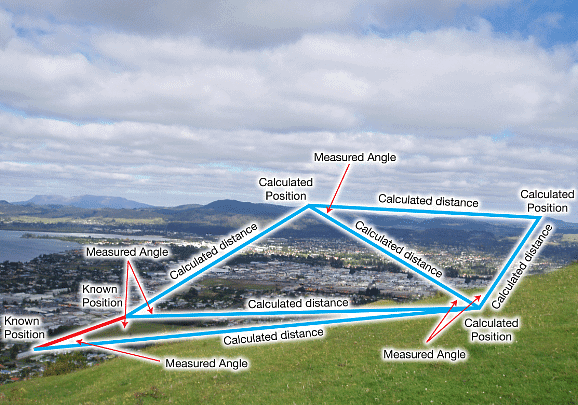What is Triangulation? | Civil Engineering Optional Notes for UPSC PDF Download
Triangulation: Overview
In the past it was difficult to accurately measure very long distances, but it was possible to accurately measure the angles between points many kilometres apart, limited only by being able to see the distant beacon. This could be anywhere from a few kilometres, to 50 kilometres or more.- Triangulation is a surveying method that measures the angles in a triangle formed by three survey control points. Using trigonometry and the measured length of just one side, the other distances in the triangle are calculated. The shape of the triangles is important as there is a lot of inaccuracy in a long skinny triangle, but one with base angles of about 45 degrees is ideal.
- Each of the calculated distances is then used as one side in another triangle to calculate the distances to another point, which in turn can start another triangle. This is done as often as necessary to form a chain of triangles connecting the origin point to the Survey Control in the place needed. The angles and distances are then used with the initial known position, and complex formulae, to calculate the position (Latitude and Longitude) of all other points in the triangulation network.
- Although the calculations used are similar to the trigonometry taught in high school, because the distance between the survey points is generally long (typically about 30 kilometres) the calculations also allow for the curvature of the Earth.
- The measured distance in the first triangle is known as the ‘Baseline’ and is the only distance measured; all the rest are calculated from it and the measured angles. Prior to the 1950s, this initial baseline distance would have to be very carefully measured with successive lengths of rods whose length were accurately known. This meant that the distance would be relatively short (maybe a kilometre or so) and it would be in a reasonably flat area, such as a valley or plain. The triangles measured from it gradually increased in size, and up onto the hilltops where distant points could be seen easily.
 Triangulation Network
Triangulation Network
The angles in the triangles are measured using a theodolite, which is an instrument with a telescope connected to two rotating circles (one horizontal and one vertical) to measure the horizontal and vertical angles. A good quality theodolite used for geodetic surveys would be graduated to 0.1 second of an arc and an angle resulting from repeated measurements would typically have an accuracy of about 1 second of arc, which is equivalent to about 5 cm over a distance of 10 kilometres.
In triangulation the vertical angles are not needed, but they can be used to measure the difference in height between the points.
Trilateration
- In the 1950s, accurate methods of measuring long distances (typically 30 to 50 km) were developed. They used the known speed of light (299,792.458 km per second) and the timed reflection of a microwave or light wave along the measured line. Known as Electromagnetic Distance Measurement (EDM), the two initial types of instrument were the ‘Tellurometer’, which used a microwave, and ‘Geodimeter’, which used a light wave.
- The distances in a triangle could then be measured directly instead of calculating them from the observed angles. If needed the angles could be calculated. The process of calculating positions through the chain of triangles is then the same as for triangulation.
- Sometimes both angles and distances were measured in some triangles to check on the observations and improve the accuracy of the calculations.
 Trilateration Network
Trilateration Network
Traversing
- Triangulation and Trilateration are difficult and sometimes impossible in flat country where there are not many hills. This is often the situation in outback areas of Australia.
- With EDM this problem can be minimised by measuring the distances and angle between successive survey control points. With a known starting position and orientation (or two known starting positions) repeating this process through a chain of points allows the position of each point to be calculated.
- However, in a traverse, if a mistake is made, it may not be obvious, so these traverses generally close back onto their starting point to form a loop, or finish on another known position. The difference between the known finishing position and the calculated position for this point is the misclose and indicates the accuracy of the traverse measurements and calculations.
 Traverse Diagram
Traverse Diagram
For small projects traversing is often used with ‘Total Station’ equipment. Variations on triangulation and trilateration are also often used on small surveys, particularly to measure to inaccessible points.
|
350 videos|464 docs|2 tests
|
|
350 videos|464 docs|2 tests
|

|
Explore Courses for UPSC exam
|

|
















